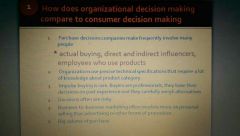![]()
![]()
![]()
Use LEFT and RIGHT arrow keys to navigate between flashcards;
Use UP and DOWN arrow keys to flip the card;
H to show hint;
A reads text to speech;
11 Cards in this Set
- Front
- Back
|
Chapter outline
|

|
|
|
organizational buyers
|
People who purchase goods and services on behalf of companies
|
|
|
Comparison between Organisational and consumer decision making
|

|
|
|
Types of family
|
1. Unintentional family: groups of unrelated people who meet regularly for meals and who spend holidays together
2. Extended family: consists of three generations who live together and it often includes grandparents, aunts, uncles, and cousins. 3. Nuclear family: consists of a mother, a father, and one or more children. |
|
|
factors for Life-Cycle Effects on Buying:
|
1. Age
2. Marital Status 3. The presence or absence of children in the home 4. The ages of children, if present |
|
|
Families make two basic types of decisions:
|
1. Consensual purchase decision: members agree on the desired purchase; they disagree only in terms of how they will make it happen
.Family will most likely engage in problem solving until they find the way to satisfy everyone in the group 2. Accommodative purchase decision: group members have different preferences or priorities and they can’t agree on a purchase to satisfy everyone’s needs . They use bargaining and compromise to achieve agreement on what to buy or who gets to use it . Conflict occurs when there is incomplete correspondence in family members’ needs and preferences |
|
|
Specific factors on how much family decision conflict:
|
1. Interpersonal need: a person’s level of investment in the group
2. Product involvement and utility: the degree to which a person will use the product to satisfy a need 3. Responsibility: for maintenance, payment and so on 4. Power: the degree to which one family member exerts influence over the other |
|
|
Children make up 3 distinct markets
|
1. Primary Market: Kids spend a lot on their own wants and needs that include toys, apparel, movies, and games
2. Influence Market: Parental yielding occurs when a parental decision maker “surrenders” to a child’s request 3. Future Market: Kids have a way of growing up to be adults |
|
|
Consumer Socialization:
|
is a process by which young people acquire skills, knowledge, and attitudes relevant to their functioning in the marketplace
|
|
|
Parents exhibit different styles when they socialize their children:
|
1. Authoritarian parents: hostile, restrictive, and emotionally uninvolved. They do not have warm relationships with their children, they censor types of media their children see
2. Neglecting parents: are detached from their children, and the parents don’t exercise much control over what their children do 3. Indulgent parents: communicate more with their children about consumptions related matters and are less restrictive. They believe that children should be allowed to learn the marketplace without much interference |
|
|
3 Developmental Stages
|
1. Limited: Children who are younger than age 6
. Do not employ storage and retrieval strategies . 2. Cued: Children between the ages of 6 and 12 . Employ these strategies but only when prompted . 3. Strategic: Children 12 and older . Spontaneously employ storage and retrieval strategies. |

